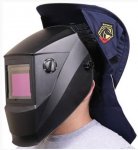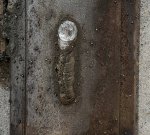Well i started welding yesterday. I have read a little about welders and generally felt mig seemed like a reasonably easy way to get started. I was going to rent a welder for the weekend but at $60 a day for a Lincoln mig, I found myself lured to the world's favorite project tool shop for a $99 Flux core wire feed 120v unit at Harbor Freight. I had low expectations and an assumption that it is just for this project and like with most cheap tools, they actually work against you if you don't know what you're doing.
On that note, my biggest mistake after setting everything up was that I only removed one side of protective film from my auto darkening helmet, so everything was blurry. Combine that with the fact that I was welding outdoors in the bright sun, i really couldn't see anything at all at first. Once I removed the second lens film and could see clearly, I was able to start to make a little more progress.
My welds are not pretty but they are pretty strong, at least for what they need to withstand (interior hand rail).
Now for the fabrication plans. I have a 13 step staircase that runs at a 35 degree angle (calculated with good old fashion math and low and behold the angle was correct). On the first step, 6th step, and top landing, I have 7/8 solid steel newel posts that I will weld to cast iron collars found at Lowes, typically used for 1" round pipe. Then those will get screwed into the stair treads and through the treads to the plywood treads, with lag bolts.
The hand rail is about 15' long so I had to weld two 8' sections together, and I'm also putting a volute on the end where the stairs begin.
At the landing, I'll cut the railing at a 35 degree angle where it meets the top landing newell post, and then there's a straight section about 42". I'll open up the wall and put a 2x4 stud exactly where my railing will meet the wall. I'll weld an anchor tab to the railing and fasten the tab to the wall with a lag bolt.
For the baulesters, I'm using a mix of straight, single knuckle, and s curves, all made of 1/2" steel. These will be tack welded to the hand rail and then set in 5/8 holes drilled with a forstner bit in the treads, and secured with epoxy.
My biggest challenges are first and foremost not having a huge shop to fabricate a 19 foot railing in, so keeping everything perfectly straight is probably not going to happen. But just as no wall in my house is perfectly plumb, I'm not going to lose any sleep over fractions of an inch as long as it looks good and I'm happy with the result.
So in terms of order of work, I am first welding the hand rail together and then I'll temporarily place the newel posts on the steps to test fit the railing. I will tack weld the railing to the newel posts while it's in place so I know that the thing will actually fit! Then I'll remove it, finish the welds of the posts, and bring it back inside. Then I'll repeat the process for the baulesters by tack welding each to the hand rail while they are lined up and in the holes drilled on the stair treads. I know that I just don't have the shop setup to do this any other way and avoid those baulesters being all over the place. Once they are welded I would rather not have to bend the welds to fit things.
After everything is tack welded I'll remove the entire railing (probably about 220lbs and we'll have three guys to move it), I'll finish any welding and do all the grinding outdoors. Then I'll coat the entire railing in primer filler and follow with flat black paint. If I can find a matte clear coat I'll add that as a final step. I will definitely set up a makeshift paint booth since we have lots of sawdust on my back patio and trees, flowers etc.
So far I'm about $1,000 in on materials (because I bought some things I didn't wind up using), $99 for the welder, and $150 in supplies and PPE. I did get a quote from an iron railing contractor and he bid $7,000 for the railing. I figure I'll be at $1,500 and a few days of time when I'm finished.
Here's a picture of one of my first welds.






